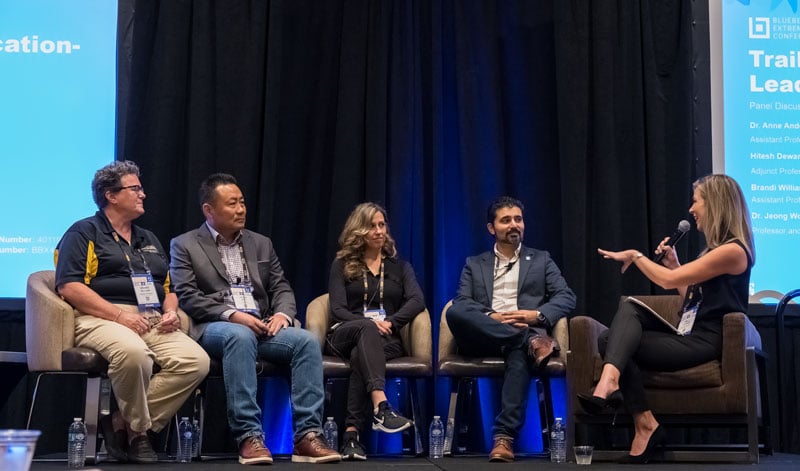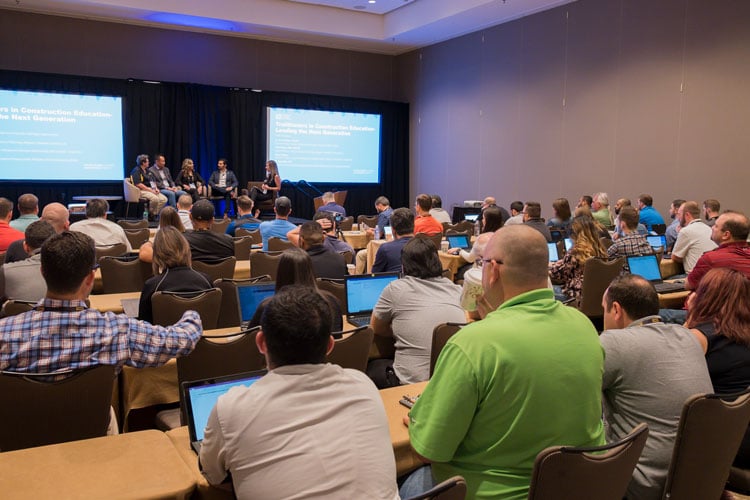At Bluebeam’s annual Extreme Conference last month in Austin, Texas, Academic Manager Emily Heppard led a panel that featured professors who are teaching to future AEC professionals.
The four professors—Brandi Williams, Assistant Professor of Construction at Kennesaw State University in Marietta, Georgia; Hitesh Dewan, Adjunct Professor of Construction Management at UC Davis Professional Education; Anne Anderson, Ph.D., Assistant Professor of Construction Management at Washington State University (WSU); and Jeong Woo, Ph.D., Professor of Civil and Architectural Engineering and Construction Management at the Milwaukee School of Engineering—spoke to the value of technology in the classroom, training students to be leaders through technology, and information sharing. We bring you some highlights:

Brandi Williams:
“For me, coming from the industry, I started when we didn’t even have fax machines. In the very first conference I went to, I asked an estimator for a large company, ‘What software should my students know?’ and he said, ‘Bluebeam.’ And so I got back and I made the call to Bluebeam, and I was shocked that they gave it away for free to the students and to our labs. The very first year that we got it, I started teaching it in my class.
“I didn’t know how to use it, and neither did the students. So, we all just jumped in together. One of the students in particular really dove in deep and learned how to do things and was teaching everybody else. Then she graduated that year, and she went to work for Inglett & Stubbs Electrical Contractors. The very first thing they asked her to do, on the very first day as her job was an assistant project manager, was to take the new Mercedes-Benz drawings and put them in some sort of order.
“She said, ‘Do you have Bluebeam?’ And they said, ‘Yes, but we don’t know how it works.’ Within an hour or so, she had taken all the drawings, updated them, put them in the proper order, segmented them properly, all the things that she had taught herself to do just by having the software. They immediately sent her on-site, and she stayed there throughout the duration of construction of the project. Now she is a project manager with Inglett & Stubbs. But without that, she probably would just have been in the office, following somebody around, making copies, doing those type things. But having this knowledge got her a better job, better opportunity, better exposure, all of it.”
Hitesh Dewan:
“At UC Davis, the classroom is encouraged to be paperless. However the e-learning system, like many universities, doesn’t directly address the nuances of construction based discussions. It thoroughly supports electronic learning and quizzing, but could do more to support planning and estimating and functions which we’re used to using.
“One common linchpin for us was being able to use Bluebeam Studio. That’s what’s really helped connect our classrooms together around plan and spec discussions and then being able to share information and markups back and forth. Most of my students are working professionals. Many of them are currently project managers that are coming back for certifications. They have a lot of insight to be to shared. When they capture that knowledge digitally, it’s something I can take to other classrooms and say, ‘Look, this is how it’s done in the industry.’
“We remind all the students across the board to learn these tools now because inevitably you’ll be using them.”
Anne Anderson:
“In one class I teach, there are construction management students and civil engineering students. It’s taught in two sections, and there are roughly 90 students in each section, and we have these little tiny desks. The first year I taught it, I’d just come from a job down in California that was almost 100% paperless, just out of necessity: it was such a huge project, there were thousands and thousands of drawings. So, I was already in the paperless mindset when I got to WSU, where there was a lot of paper.
“In the past, the students would carry around three different plan sets. I wanted to bring some active learning into the classroom, which meant I wanted them to bring their drawings in. So that’s why we started using Bluebeam Revu. I said, ‘This a paperless classroom but you can get paper if you want to.’ That was their choice in the first year. I got rid of that after the first year, because it just turned out to be a disaster. Some of the students did choose to get paper, and then they’d be sitting in the classroom with these little tiny desks trying to open up their drawings and see what’s going on, and it was just crazy. So, I banned paper after that first year. Now we just use 100% Bluebeam.
“I would tell them that this is what we use in the industry, but they can use any program they want. But they saw as they watched their peers using Bluebeam how great it is and what it could do, all the functionality. I’d get about half the students on board right away, and then throughout the semester, the others see what this amazing tool is all about. Especially the fast navigation. During exams they have to navigate through 350 pages of drawings.”
Jeong Woo:
“We have a one-year-long design-build studio. We invite a few real project owners with projects in the early design stage, so they already have architects and sometimes they even have construction companies. What we do is, we use the exact same documents, like surveying and plot plans, and then we develop an alternative design set for the building owners. We invite all the project stakeholders to the design-build studio, like the owner, architects, engineers, contractors and city officials, for design and code review. That’s the same design process we would use for a real project. We form multidisciplinary student teams, including majors from architectural engineering, civil engineering and construction management. Each team has students specializing in structural engineering, as well as mechanical and electrical building systems.
“Each team has one or two of those majors and then they develop architecture designs sets, and engineering and construction management solutions. In that class, it’s really important to get feedback from the industry. We use mentors and adjunct faculty members who come in to do some critiques, and we’ve started using Bluebeam Studio to share the students’ work so some outside folks can do virtual critiques.
“Because we have sponsoring companies, industry advisers, a network of alumni, much of what I do is matchmaking. For example, I assign a scheduling project and find somebody working as a scheduler, or I find a superintendent or project manager who can review a site logistics plans and a quality control plan. It’s amazing to see things come together.”











